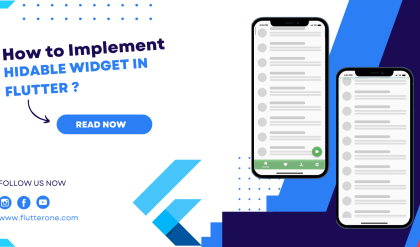Creating a responsive user interface is crucial for delivering a seamless experience across different screen sizes and orientations. Flutter provides a powerful widget called LayoutBuilder that allows you to build adaptive UIs that respond to changes in the available space. In this guide, we’ll explore how to use the LayoutBuilder widget to create responsive layouts in Flutter, dynamically adjusting the UI based on screen constraints.
What is the LayoutBuilder Widget?
The LayoutBuilder widget in Flutter provides a way to obtain information about the available space for rendering widgets within a layout. It wraps a subtree of widgets and provides a builder function that receives a BuildContext and BoxConstraints. The BoxConstraints object represents the constraints on the layout, including the minimum and maximum width and height.
By leveraging the LayoutBuilder widget, you can access the available space and make informed decisions about how to layout and size your widgets based on the constraints. This allows you to create adaptive UIs that automatically adjust to different screen sizes and orientations.
Building a Responsive UI with LayoutBuilder
To build a responsive UI using the LayoutBuilder widget, follow these steps:
- Wrap your layout widgets with the LayoutBuilder widget.
- Implement the builder function to define how the UI should respond to the available space.
Here’s an example of building a responsive UI using the LayoutBuilder widget:
import 'package:flutter/material.dart';
class ResponsiveUIExample extends StatelessWidget {
@override
Widget build(BuildContext context) {
return Scaffold(
appBar: AppBar(
title: Text('Responsive UI Example'),
),
body: LayoutBuilder(
builder: (BuildContext context, BoxConstraints constraints) {
if (constraints.maxWidth > 600) {
return _buildWideLayout();
} else {
return _buildNarrowLayout();
}
},
),
);
}
Widget _buildWideLayout() {
// Build UI for wide layout
return Container(
child: Text('Wide Layout'),
);
}
Widget _buildNarrowLayout() {
// Build UI for narrow layout
return Container(
child: Text('Narrow Layout'),
);
}
}
In this example, the LayoutBuilder widget is used to determine whether the available space is wide or narrow. If the maximum width is greater than 600, it renders the wide layout; otherwise, it renders the narrow layout. You can customize the layout and widget tree within the respective methods _buildWideLayout() and _buildNarrowLayout().
By adapting the UI based on available space, you can provide an optimized experience for users on different devices and screen sizes.
Best Practices for Responsive UI Design
Here are some best practices to keep in mind when designing responsive UIs in Flutter:
- Test on Multiple Devices: Ensure that you test your app’s UI on various devices with different screen sizes and resolutions. This helps identify any layout issues or inconsistencies that may arise on specific devices.
- Utilize MediaQuery: Take advantage of the MediaQuery widget to access device-specific information such as screen size, orientation, and pixel density. Use this information to make responsive design decisions and adjust the UI accordingly.
import 'package:flutter/material.dart'; class MyWidget extends StatelessWidget { @override Widget build(BuildContext context) { final mediaQuery = MediaQuery.of(context); final screenWidth = mediaQuery.size.width; final screenHeight = mediaQuery.size.height; return Container( width: screenWidth * 0.8, // Use a percentage of the screen width height: screenHeight * 0.5, // Use a percentage of the screen height child: Text('Responsive Widget'), ); } } - Responsive Widgets: Flutter provides several built-in widgets that are designed for responsive layouts. Utilize widgets like Expanded and Flexible to create fluid and adaptable UIs that adjust to available space and screen sizes.
import 'package:flutter/material.dart'; class MyLayout extends StatelessWidget { @override Widget build(BuildContext context) { return Row( children: [ Expanded( flex: 2, child: Container( color: Colors.blue, child: Text('Left Section'), ), ), Expanded( flex: 3, child: Container( color: Colors.red, child: Text('Right Section'), ), ), ], ); } } - Define Breakpoints: Define specific breakpoints in your UI design to trigger layout changes at different screen sizes. This allows for adaptive design where the UI adjusts and rearranges itself to provide the best user experience for each screen size.
import 'package:flutter/material.dart'; class MyWidget extends StatelessWidget { @override Widget build(BuildContext context) { final mediaQuery = MediaQuery.of(context); final screenWidth = mediaQuery.size.width; if (screenWidth >= 600) { return Container( color: Colors.blue, child: Text('Wide Layout'), ); } else { return Container( color: Colors.red, child: Text('Narrow Layout'), ); } } } - Handle Orientation Changes: Consider how your UI should adapt when the device orientation changes. Update the layout, reposition elements, and adjust the sizing to ensure a seamless user experience in both portrait and landscape orientations.
import 'package:flutter/material.dart'; class MyWidget extends StatelessWidget { @override Widget build(BuildContext context) { return OrientationBuilder( builder: (BuildContext context, Orientation orientation) { if (orientation == Orientation.portrait) { return Container( color: Colors.blue, child: Text('Portrait Mode'), ); } else { return Container( color: Colors.red, child: Text('Landscape Mode'), ); } }, ); } } - Avoid Hardcoding Values: Instead of hardcoding specific sizes or dimensions, utilize relative or flexible values. This allows the UI to scale and adapt based on the available screen space, providing a consistent experience across different devices.
- Use Constraints Wisely: When working with the LayoutBuilder widget, make use of the BoxConstraints object provided in the builder function. Leverage the min and max constraints to define how widgets should respond to different space limitations.
- Consider Accessibility: Keep accessibility in mind when designing responsive UIs. Ensure that your UI remains accessible and usable for users with different abilities and assistive technologies.
- Performance Optimization: Optimize your responsive UI for performance by minimizing unnecessary layout calculations and widget rebuilds. Utilize techniques like memoization and state management to efficiently handle UI updates.
- User Testing and Feedback: Gather user feedback and conduct usability testing to validate the effectiveness of your responsive UI. Solicit feedback from users on different devices to ensure a positive and consistent user experience.
Conclusion
Flutter’s LayoutBuilder widget empowers you to build responsive and adaptive UIs that seamlessly adapt to different screen sizes and orientations. By leveraging the available space and making informed layout decisions, you can create user interfaces that provide an optimal user experience across a wide range of devices. Remember to test your responsive UI on various devices to ensure consistent performance and usability. Start building responsive Flutter apps today and deliver delightful experiences to your users.
Customize the title and meta description based on your blog’s SEO strategy and target keywords to maximize visibility and reach.






